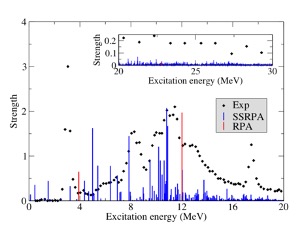
A recent extension of density functional theories has helped explain the disagreement between measurements of Gamow-Teller (GT) resonances in nuclei and a large number of theoretical predictions. In particular, a strong disagreement exists between the experimental measurement and the theoretical predictions of the GT spectrum in the 48Ca nucleus. All existing calculations must resort to ad hoc adjustments, with reduction factors for the transition operator.A study conducted by Marcella Grasso (Nuclear Physics Pole, PhyNeT Team) and her collaborators at LNS-INFN Catania and the University of North Carolina showed that a prediction without adjustments can be obtained with improved processing of coherent motion of the cells. nucleons, and that the key to this result is the explicit inclusion of some complex, hitherto neglected nucleon configurations. The 48Ca nucleus is one of the possible emitters in the neutrino-emitting (0νββ) double beta decay ββ process, a process that has never been observed and continues to be actively sought around the world.
To predict the lifetime of this decay, nuclear matrix elements are needed, which can be obtained only through theoretical calculations of nuclear structure. It turns out that the GT-type contribution is very important in these matrix elements and dominates compared to the other contributions. Even though GT resonances and decay ββ are very different phenomena, the theoretical model adopted to calculate the nuclear matrix elements will be considered more reliable if it also correctly reproduces the experimental GT spectra, without reduction factors. It is in this context that the international collaboration that led this study will probably make an important contribution: the same theoretical framework will soon be applied to 0νββ degrowth.





